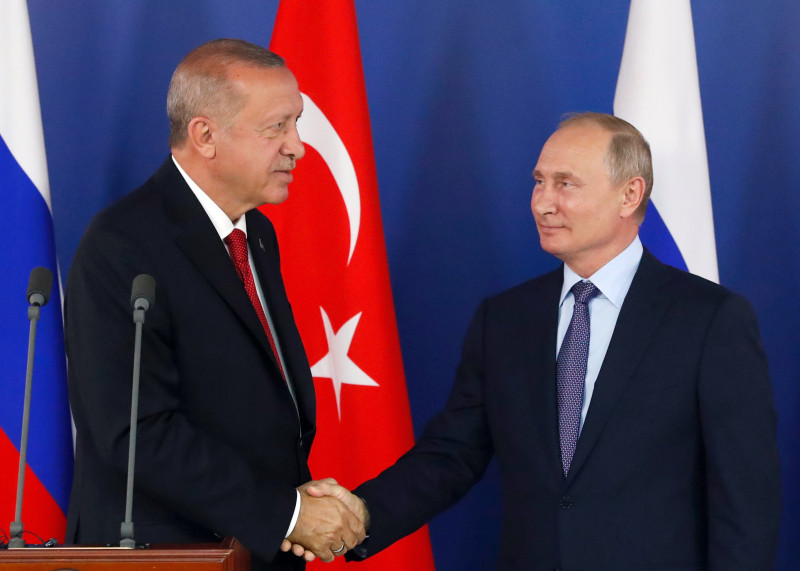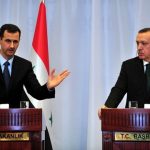Russian troops are already ordering the Kurds to give up territory, or face a renewed onslaught from Turkey.
Russian military police arrived in the Syrian city of Kobani Wednesday to deliver a message to Kurdish forces: pull back 19 miles from the border, or face a renewed onslaught from Turkey.
Those are the terms of a new agreement reached between Turkey and Russia Tuesday which, if enacted, will force Kurdish fighters from the Syria-Turkey border, expanding on their territorial losses since President Trump suddenly cut U.S. support for its ally earlier this month.
Following a marathon six hours of talks in the Russian Black Sea resort of Sochi, Russian President Vladimir Putin and his Turkish counterpart Recep Tayyip Erdogan unveiled a 10-point memorandum of understanding that would carve up territory previously held by Kurdish forces, against whom Turkey launched a cross-border offensive earlier this month.
The deal, which analysts say would be devastating for the Kurds’ ambitions of political autonomy in northeast Syria, was hailed as a historic success by both Moscow and Ankara. It would entrench and expand Turkey’s long-sought buffer zone, cleared of Kurdish forces, on the Syrian side of the border, while cementing Moscow’s new status as the conflict’s leading powerbroker, at Washington’s expense.
Turkey said the agreement meant it did not need to resume its assault on the Kurds, temporarily halted by a U.S.-brokered ceasefire which expired Tuesday night.
“According to this agreement, Turkey and Russia will not allow any separatist agenda on Syrian territory,” Erdogan said.
What does the deal say?
Turkey launched its offensive against Kurdish forces on Oct. 9, claiming the need to create a “safe zone” in Syrian territory along its border that was cleared of Kurdish forces. Ankara considers the Syrian Kurds as terrorists who are intrinsically linked to Kurdish militants waging an insurgency on Turkish soil.
Turkey has already seized a 75 mile-long strip of land between the towns of Ras al-Ain and Tal Abyad in the fighting, which, under the agreement, it can keep as its safe zone, with a depth extending 20 miles into Syria. The deal states that Kurdish militias will be given 150 hours from midday on Wednesday to withdraw from a larger stretch of territory either side of that area to a depth of 19 miles from the border.
Once that deadline passes, Ankara and Moscow will run joint patrols east and west of the Turkish-controlled area, to a depth of 6 miles from the border, with the exception of the de facto Kurdish capital of Qamishli.
Will it work?
The Kurds, for one, have not given any indication whether they consent to the punishing terms of the agreement. The deal would represent the further capitulation of Kurdish territory following an earlier ceasefire brokered between the U.S. and Turkey — and would effectively put an end to the prospect of Kurdish post-war political autonomy in northeast Syria, Ege Seckin, principal analyst at IHS Markit Country Risk, told VICE News.
But fighting the Turkish offensive has come at a heavy price for the Kurds. Since the U.S. suddenly withdrew the military support, the Kurds have lost about 260 fighters, while about 120 civilians have been killed.
Kremlin spokesman Dmitry Peskov said Wednesday that if Kurdish forces did not retreat, Russian and Syrian forces would withdraw and leave them to face a Turkish offensive.
Nevertheless Jim Jeffrey, the senior U.S. diplomat on Syria, questioned Tuesday whether Kurdish forces would voluntarily withdraw from the area laid out in the deal.
“It’s full of holes,” he said at a congressional hearing. “All I know it will stop the Turks from moving forward. Whether the Russians will ever live up to their commitment, which is very vague, to … get the [Kurdish forces] out of their areas, I don’t know.”
Who wins and who loses?
Analysts say the agreement is further bad news for the Kurds, and a win for Turkey, Russia and Syria.
“The deal in northeast Syria hurts Kurdish ambitions of achieving a degree of autonomy, and benefits Russia and Assad, particularly as it grants Assad de facto recognition by Turkey,” Lina Khatib, head of the Middle East and North Africa programme at the Chatham House think tank told VICE News.
Meanwhile, “Turkey got the safe zone it wanted all this time.” Soner Cagaptay, director of the Turkish program at the Washington Institute said in a tweet. “The outcome of the Putin-Erdogan meeting in Sochi today indicates that Erdogan has become a master of leveraging the U.S. and Russia against each other to maximize Ankara’s gains.”
For Russia, the result is also a win, allowing Putin to present the deal as a foreign policy victory that protects sovereignty and territorial integrity of its ally Syria, while cementing its new status as the leading powerbroker in the conflict following the sudden U.S. pullout.
“Russia sees the deal as paving the way for reintegrating the Assad regime into the international community,” said Khatib.
For Trump though, who has maintained the U.S. has no business in the conflict, the ceding of influence in Syria appeared to be no great loss. “Big success on the Turkey/Syria Border. Safe Zone created! Ceasefire has held and combat missions have ended. Kurds are safe and have worked very nicely with us,” he tweeted Wednesday.
Cover: In this photo taken Tuesday, Oct. 22, 2019, Russian President Vladimir Putin, right, and Turkish President Recep Tayyip Erdogan shake hands after a joint news conference, hours before a five-day cease-fire between Turkish troops and Kurdish fighters in northeastern Syria was set to expire, in Sochi, Russia. (Presidential Press Service via AP, Pool )
By Tim Hume
Source: Vice News



